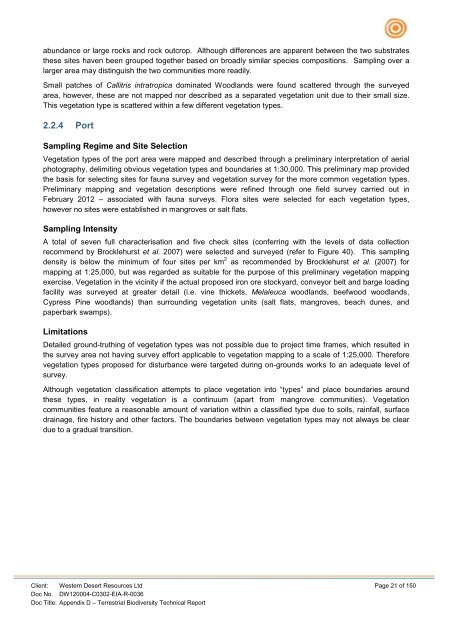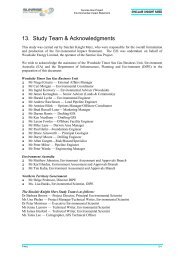- Page 1 and 2: EcOz Environmental Services Draft E
- Page 3 and 4: Document Control Record Prepared by
- Page 5 and 6: 5.5 Sensitive Habitats ............
- Page 7 and 8: Figure 25: Notable habitat identifi
- Page 9 and 10: Appendices FAUNA APPENDICES Appendi
- Page 11 and 12: Figure 1: Locations for three propo
- Page 13 and 14: Table 1: A summary of key informati
- Page 15 and 16: • Fine scale vegetation mapping (
- Page 17 and 18: Coastal Port Facilities The coastal
- Page 19 and 20: “Vegetation mapping is not an exa
- Page 21: • Water bodies - The waterbodies
- Page 25 and 26: Haul Road Transport Corridor Five s
- Page 27 and 28: Figure 2: Map of all fauna survey l
- Page 29 and 30: Bat Survey Bat species present were
- Page 31 and 32: The Freshwater fish surveys were ca
- Page 33 and 34: 2.6 Targeted Surveys 2.6.1 Bare-rum
- Page 35 and 36: Figure 3: The IUCN Red List categor
- Page 37 and 38: D-3. Desktop Review 3.1 Climate The
- Page 39 and 40: 3.3 Sites of Conservation Significa
- Page 41 and 42: 3.4 Topography and Geomorphology Th
- Page 43 and 44: Figure 6: Five-year fire scar map o
- Page 45 and 46: 3.6 Weeds Weed data was collected f
- Page 47 and 48: 3.7.2 Flora Records Flora surveys w
- Page 49 and 50: Figure 10: Map of existing flora re
- Page 51 and 52: Figure 11: Proposed site layout pla
- Page 53 and 54: Table 9: Five main vegetation and l
- Page 55 and 56: Veg. Type Table 10: Vegetation Type
- Page 57 and 58: Figure 13: Five main vegetation typ
- Page 59 and 60: 4.3.2 Vegetation Condition The fire
- Page 61 and 62: (note that conceptual site layout h
- Page 63 and 64: It is unknown whether an increase o
- Page 65 and 66: (note that conceptual site layout h
- Page 67 and 68: (note that conceptual site layout h
- Page 69 and 70: Site Photo Description F5 F6 F7 F8a
- Page 71 and 72: Site Photo Description F12 F13 F14
- Page 73 and 74:
4.5.2 Fauna Survey Results The Wet
- Page 75 and 76:
• The remaining species are all l
- Page 77 and 78:
Figure 24: Locations of freshwater
- Page 79 and 80:
4.7 Bare-rumped Sheathtail Bat Surv
- Page 81 and 82:
Figure 25: Notable habitat identifi
- Page 83 and 84:
Sections of the McArthur land syste
- Page 85 and 86:
Table 14: Land system and vegetatio
- Page 87 and 88:
Land System Landform Soils Vegetati
- Page 89 and 90:
5.3 Vegetation Surveys National Veg
- Page 91 and 92:
NVIS Level 3 Veg ID Description (ad
- Page 93 and 94:
Figure 27: Haul road (and surrounds
- Page 95 and 96:
5.3.1 Notable flora records Surveys
- Page 97 and 98:
Towns Survey - Lower Reaches Site 4
- Page 99 and 100:
Towns Survey - Upper Site 3 Site 4
- Page 101 and 102:
Table 18: Fauna site habitat descri
- Page 103 and 104:
Table 19: Fauna site habitat descri
- Page 105 and 106:
Table 20: Fauna site habitat descri
- Page 107 and 108:
diversity. The riparian zone and ad
- Page 109 and 110:
Figure 34: Map 1 of 4 - Haul road s
- Page 111 and 112:
Figure 36: Map 3 of 4 - Haul road s
- Page 113 and 114:
5.5.2 Rocky Sandstone Ridges Rocky
- Page 115 and 116:
feature the three species of freshw
- Page 117 and 118:
Figure 39: Land system map of the c
- Page 119 and 120:
Table 22: Vegetation type summaries
- Page 121 and 122:
6.3.2 Vegetation Condition The vege
- Page 123 and 124:
6.3.4 Introduced Plant Species Envi
- Page 125 and 126:
Site Photo Description Site 4 Site
- Page 127 and 128:
6.4.2 Fauna Survey Results The surv
- Page 129 and 130:
6.5 Sensitive Habitats None of the
- Page 131 and 132:
6.5.4 Melaleuca Swamp This is a rel
- Page 133 and 134:
Figure 46: Map of threatened and no
- Page 135 and 136:
SCIENTIFIC NAME Falcunculus frontat
- Page 137 and 138:
7.1.2 Migratory Shorebirds The Gulf
- Page 139 and 140:
Figure 48: Location of MLA and haul
- Page 141 and 142:
7.1.4 Proposed Status Changes In 20
- Page 143 and 144:
Table 29: Notable flora species wit
- Page 145 and 146:
SCIENTIFIC NAME LENTIBULARIACEAE Ut
- Page 147 and 148:
7.3 Sensitive Habitat 7.3.1 MLA Are
- Page 149 and 150:
D-9. References Aldrick, JM & Wilso
- Page 151 and 152:
NRETAS 2006, Threatened Species of
- Page 153 and 154:
Client: Western Desert Resources Lt
- Page 155 and 156:
SCIENTIFIC NAME COMMON NAME Client:
- Page 157 and 158:
SCIENTIFIC NAME COMMON NAME Client:
- Page 159 and 160:
SCIENTIFIC NAME COMMON NAME Client:
- Page 161 and 162:
SCIENTIFIC NAME COMMON NAME Client:
- Page 163 and 164:
SCIENTIFIC NAME COMMON NAME Client:
- Page 165 and 166:
SCIENTIFIC NAME COMMON NAME Client:
- Page 167 and 168:
SCIENTIFIC NAME COMMON NAME VARANID
- Page 169 and 170:
Client: Western Desert Resources Lt
- Page 171 and 172:
Client: Western Desert Resources Lt
- Page 173 and 174:
SCIENTIFIC NAME COMMON NAME STATU S
- Page 175 and 176:
Table 2-3: Mammals found from MLA f
- Page 177 and 178:
SCIENTIFIC NAME COMMON NAME Client:
- Page 179 and 180:
SCIENTIFIC NAME COMMON NAME Client:
- Page 181 and 182:
Table 2-5: Freshwater vertebrates f
- Page 183 and 184:
Client: Western Desert Resources Lt
- Page 185 and 186:
SCIENTIFIC NAME COMMON NAME Delma b
- Page 187 and 188:
Table 3-3: Mammals found from Haul
- Page 189 and 190:
SCIENTIFIC NAME COMMON NAME BURHINI
- Page 191 and 192:
SCIENTIFIC NAME COMMON NAME Client:
- Page 193 and 194:
Client: Western Desert Resources Lt
- Page 195 and 196:
Client: Western Desert Resources Lt
- Page 197 and 198:
Table 4-2: Amphibians found from Po
- Page 199 and 200:
SCIENTIFIC NAME COMMON NAME Geopeli
- Page 201 and 202:
Client: Western Desert Resources Lt
- Page 203 and 204:
Client: Western Desert Resources Lt
- Page 205 and 206:
SZ247: Bat survey from the Western
- Page 207 and 208:
SZ247: Bat survey from the Western
- Page 209 and 210:
SZ247: Bat survey from the Western
- Page 211 and 212:
SZ247: Bat survey from the Western
- Page 213 and 214:
SZ247: Bat survey from the Western
- Page 215 and 216:
SZ247: Bat survey from the Western
- Page 217 and 218:
SZ247: Bat survey from the Western
- Page 219 and 220:
SZ247: Bat survey from the Western
- Page 221 and 222:
SZ247: Bat survey from the Western
- Page 223 and 224:
SZ247: Bat survey from the Western
- Page 225 and 226:
SZ247: Bat survey from the Western
- Page 227 and 228:
SZ247: Bat survey from the Western
- Page 229 and 230:
SZ247: Bat survey from the Western
- Page 231 and 232:
SZ247: Bat survey from the Western
- Page 233 and 234:
SZ247: Bat survey from the Western
- Page 235 and 236:
SZ247: Bat survey from the Western
- Page 237 and 238:
Client: Western Desert Resources Lt
- Page 239 and 240:
Client: Western Desert Resources Lt
- Page 241 and 242:
SCIENTIFIC NAME COMMON NAME Client:
- Page 243 and 244:
Client: Western Desert Resources Lt
- Page 245 and 246:
Client: Western Desert Resources Lt
- Page 247 and 248:
SCIENTIFIC NAME COMMON NAME Client:
- Page 249 and 250:
SCIENTIFIC NAME COMMON NAME Client:
- Page 251 and 252:
Client: Western Desert Resources Lt
- Page 253 and 254:
Client: Western Desert Resources Lt
- Page 255 and 256:
Client: Western Desert Resources Lt
- Page 257 and 258:
Client: Western Desert Resources Lt
- Page 259 and 260:
Client: Western Desert Resources Lt
- Page 261 and 262:
Client: Western Desert Resources Lt
- Page 263 and 264:
Client: Western Desert Resources Lt
- Page 265 and 266:
Client: Western Desert Resources Lt
- Page 267 and 268:
Ground: Alloteropsis semialata (fq
- Page 269 and 270:
Ground: Portulaca bicolor (fq 75%),
- Page 271 and 272:
Upper: Low open woodland dominated
- Page 273 and 274:
mitrasacmoides (fq 50%), Panicum ef
- Page 275 and 276:
Ground: Murdannia graminea (fq 100%
- Page 277 and 278:
25%), Jacksonia odontoclada (fq 25%
- Page 279 and 280:
Ground: Crotalaria montana (fq 33%)
- Page 281 and 282:
Carissa lanceolata (fq 25%), Dolich
- Page 283 and 284:
33%), Dimeria ornithopoda (fq 33%),
- Page 285 and 286:
Landform: simple slope General Cond
- Page 287 and 288:
Ground: Polygala longifolia (fq 67%
- Page 289 and 290:
Ground: Ammannia multiflora (fq 100
- Page 291 and 292:
Ground: Alloteropsis semialata (fq
- Page 293 and 294:
cunninghamii (fq 67%), Grevillea pa
- Page 295 and 296:
Ground: Bulbostylis barbata (fq 67%
- Page 297 and 298:
Desmodium brownii (fq 20%), Desmodi
- Page 299 and 300:
graminea (fq 33%), Nesaea muelleri
- Page 301 and 302:
trifolia (fq 33%), Cyperus holoscho
- Page 303 and 304:
microcephala (fq 67%), Melochia cor
- Page 305 and 306:
General Condition: This single site
- Page 307 and 308:
Client: Western Desert Resources Lt
- Page 309 and 310:
Site ID Map Easting Northing Descri
- Page 311 and 312:
Table 10-3: Vegetation Assessment o
- Page 313 and 314:
Table 10-5: Vegetation Assessment o
- Page 315 and 316:
Site ID Map Easting Northing W54 2
- Page 317 and 318:
Site ID Map Easting Northing Client
- Page 319 and 320:
Table 10-8: Riparian Vegetation Ass
- Page 321 and 322:
Table 10-10: Riparian Vegetation As
- Page 323 and 324:
Table 10-12: Riparian Vegetation As
- Page 325 and 326:
Table 10-14: Riparian Vegetation As
- Page 327 and 328:
Client: Western Desert Resources Lt
- Page 329 and 330:
Table 11-2: Port Area. Vegetation U
- Page 331 and 332:
Table 11-4: Port Area. Vegetation U
- Page 333 and 334:
Client: Western Desert Resources Lt
- Page 335 and 336:
Client: Western Desert Resources Lt
- Page 337:
Voucher No. Strata labels Biodivers



